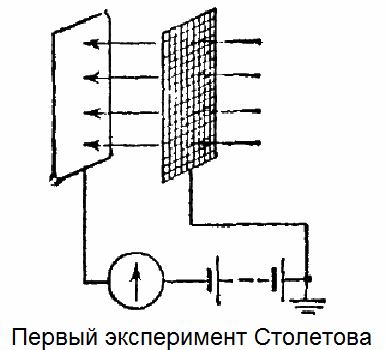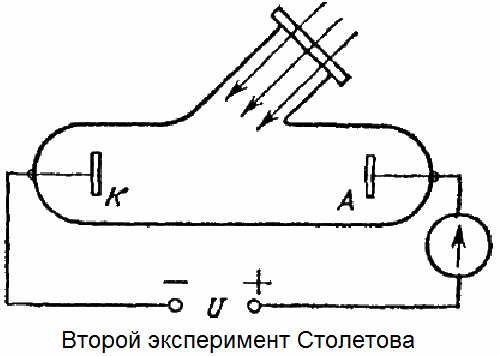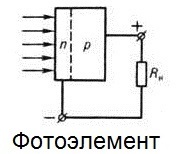Semiconductor photovoltaic energy converters (photocells)
Photocells are electronic devices designed to convert the energy of photons into the energy of an electric current.
Historically, the first prototype of the modern photocell was invented Alexander G. Stoletov at the end of the 19th century. He creates a device that works on the principle of external photoelectric effect. The first experimental installation consisted of a pair of parallel flat metal sheets, one of which was made of mesh to allow light to pass through and the other was solid.

A constant voltage was applied to the sheets, which could be adjusted in the range of 0 to 250 volts. The positive pole of the voltage source was connected to the grid electrode and the negative pole to the solid. A sensitive galvanometer was also included in the scheme.
When a solid sheet was illuminated with light from an electric arc, galvanometer needle deflected, indicating that a direct current is being generated in the circuit despite the fact that there is air between the discs.In the experiment, the scientist found that the magnitude of the "photocurrent" depends on both the applied voltage and the intensity of the light.

Complicating the installation, Stoletov places the electrodes inside a cylinder from which air is evacuated, and ultraviolet light is fed to the sensitive electrode through a quartz window. So it was open photo effect.
Today, based on this effect, it works photovoltaic converters… They react to electromagnetic radiation falling on the surface of the element and convert it into an output voltage. An example of such a converter is solar cell… The same principle is used by photosensitive sensors.
A typical photocell consists of a layer of high resistance photosensitive material sandwiched between two conductive electrodes. As a photovoltaic material for solar cells, it is commonly used semiconductor, which, when fully illuminated, is capable of giving 0.5 volts at the output.
Such elements are most efficient from the point of view of generated energy, as they allow direct one-step transfer of photon energy — in electric current... Under normal conditions, an efficiency of 28% is the norm for such elements.

Here, an intense photoelectric effect occurs due to the inhomogeneity of the semiconductor structure of the working material.This inhomogeneity is obtained either by doping the semiconductor material used with different impurities, thereby creating a pn junction, or by connecting semiconductors with different gap sizes (energies at which electrons leave their atoms)—thus obtains a heterojunction, or by choosing such a chemical composition of the semiconductor that a bandgap gradient—a graded-gap structure—appears inside. As a result, the efficiency of a given element depends on the inhomogeneity characteristics obtained inside a particular semiconductor structure as well as the photoconductivity.

To reduce losses in a solar cell, a number of regulations are used in their manufacture. First, semiconductors are used whose bandgap is optimal just for sunlight, for example compounds of silicon and gallium arsenide. Second, the properties of the structure are improved by optimal alloying. Preference is given to heterogeneous and graded structures. The optimal thickness of the layer, the depth of the p-n-junction and the best parameters of the contact grid are selected.
Cascade elements are also created, where several semiconductors with different frequency bands work, so that after passing through one cascade, the light enters the next, etc. The idea of decomposing the solar spectrum looks promising, so that each of its regions is transformed from separate section of photocell.
There are three main types of photovoltaic cells on the market today: monocrystalline silicon, polycrystalline silicon, and thin film.Thin films are considered the most promising because they are sensitive even to stray light, can be placed on curved surfaces, are not as brittle as silicon, and are effective even at high operating temperatures.
See also: Efficiency of solar cells and modules

